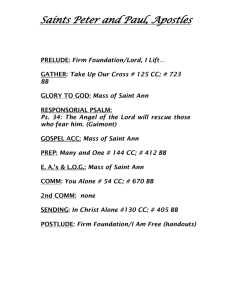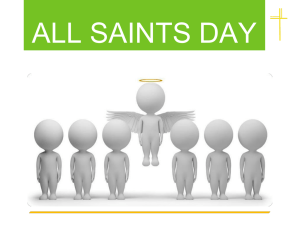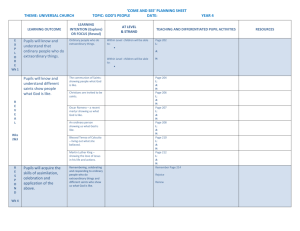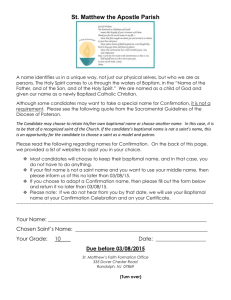Domestic animals as symbols and attributes in Christian
advertisement
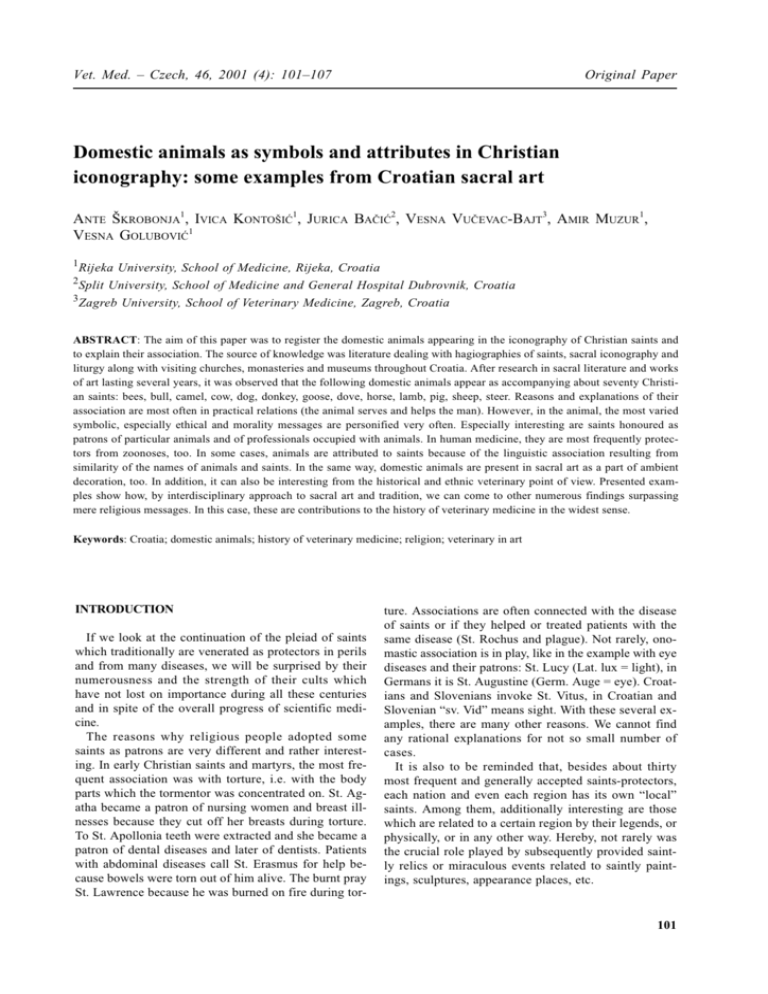
Original Paper Vet. Med. – Czech, 46, 2001 (4): 101–107 Domestic animals as symbols and attributes in Christian iconography: some examples from Croatian sacral art ANTE KROBONJA1, IVICA KONTOIÆ1, JURICA BAÈIÆ2, VESNA VUÈEVAC-BAJT3, AMIR MUZUR1, VESNA GOLUBOVIÆ1 1 Rijeka University, School of Medicine, Rijeka, Croatia Split University, School of Medicine and General Hospital Dubrovnik, Croatia 3 Zagreb University, School of Veterinary Medicine, Zagreb, Croatia 2 ABSTRACT: The aim of this paper was to register the domestic animals appearing in the iconography of Christian saints and to explain their association. The source of knowledge was literature dealing with hagiographies of saints, sacral iconography and liturgy along with visiting churches, monasteries and museums throughout Croatia. After research in sacral literature and works of art lasting several years, it was observed that the following domestic animals appear as accompanying about seventy Christian saints: bees, bull, camel, cow, dog, donkey, goose, dove, horse, lamb, pig, sheep, steer. Reasons and explanations of their association are most often in practical relations (the animal serves and helps the man). However, in the animal, the most varied symbolic, especially ethical and morality messages are personified very often. Especially interesting are saints honoured as patrons of particular animals and of professionals occupied with animals. In human medicine, they are most frequently protectors from zoonoses, too. In some cases, animals are attributed to saints because of the linguistic association resulting from similarity of the names of animals and saints. In the same way, domestic animals are present in sacral art as a part of ambient decoration, too. In addition, it can also be interesting from the historical and ethnic veterinary point of view. Presented examples show how, by interdisciplinary approach to sacral art and tradition, we can come to other numerous findings surpassing mere religious messages. In this case, these are contributions to the history of veterinary medicine in the widest sense. Keywords: Croatia; domestic animals; history of veterinary medicine; religion; veterinary in art INTRODUCTION If we look at the continuation of the pleiad of saints which traditionally are venerated as protectors in perils and from many diseases, we will be surprised by their numerousness and the strength of their cults which have not lost on importance during all these centuries and in spite of the overall progress of scientific medicine. The reasons why religious people adopted some saints as patrons are very different and rather interesting. In early Christian saints and martyrs, the most frequent association was with torture, i.e. with the body parts which the tormentor was concentrated on. St. Agatha became a patron of nursing women and breast illnesses because they cut off her breasts during torture. To St. Apollonia teeth were extracted and she became a patron of dental diseases and later of dentists. Patients with abdominal diseases call St. Erasmus for help because bowels were torn out of him alive. The burnt pray St. Lawrence because he was burned on fire during tor- ture. Associations are often connected with the disease of saints or if they helped or treated patients with the same disease (St. Rochus and plague). Not rarely, onomastic association is in play, like in the example with eye diseases and their patrons: St. Lucy (Lat. lux = light), in Germans it is St. Augustine (Germ. Auge = eye). Croatians and Slovenians invoke St. Vitus, in Croatian and Slovenian sv. Vid means sight. With these several examples, there are many other reasons. We cannot find any rational explanations for not so small number of cases. It is also to be reminded that, besides about thirty most frequent and generally accepted saints-protectors, each nation and even each region has its own local saints. Among them, additionally interesting are those which are related to a certain region by their legends, or physically, or in any other way. Hereby, not rarely was the crucial role played by subsequently provided saintly relics or miraculous events related to saintly paintings, sculptures, appearance places, etc. 101 Original Paper AIM AND METHODS As the authors have been occupied for a longer time with themes treating connections of medicine, in the widest sense, and religion or sacral art, they have noticed that not rarely are in the iconography of saints met numerous animals as well. They are sometimes directly associated with saints or they have a definite, most often metaphoric or symbolic mean. In literature it is little written about this theme. Therefore, the aim of this study is to make a short review of domestic animals appearing with certain saints and to explain their interrelation or their iconographic symbolism in the context of Christian tradition. As in previous papers with similar themes (Muzur and krobonja, 1995; krobonja and Muzur, 1998; krobonja et al., 1999), identical methods were applied this time, too. Data were collected from basic theological literature (Old and New Testament), and encyclopaedic editions in this field (Glazier and Helwig, 1998). General hagiographic literature and special bibliographic studies about the saints-protectors followed (Stein, 1991; Sterpelone, 1994; Peñlosa, 1995). Literature about sacral iconography, liturgics and symbolics was especially worthy (Chevalier and Gheerbrant, 1983; Badurna, 1990). Another part of knowledge was collected during studies in the field lasting several years. Along with visiting churches, monasteries and museums throughout Croatia, numerous discussions were performed and many interesting objects were visited and photographed. Four most characteristic photographs were chosen for this occasion from our own photo library created in this way. RESULTS After the basic review of available literature and collected material, many examples of domestic animal presence in sacral iconography were registered and selected. However, for practical reasons, only the most frequently mentioned animals, their symbolic meanings and connection with certain saints will be mentioned in an informal order. Camel is the symbol of cognition because it never accepts excessive load. Nevertheless, it is also the symbol of obedience because it always kneels down to be loaded more easily. In the cycle of the continents personification, it represents Asia. In Old Testament the caravan of camels is frequent in the scenes about Rachel and Rebecca, and in the motives from New Testament with Three Holy Kings, who came to the manger on camels. In relation to early Christian saints, the caravan of camels in a desert is in the function of the ambient of St. Jerome, who translates biblical texts in ascetic isolation. Two camels kneeling beside the grave indicate St. Men102 Vet. Med. – Czech, 46, 2001 (4): 101–107 nas, whose dead body they carried before that along Memphis towards his burial place. In accordance with one of the numerous legends connected with holy physicians St. Cosmas and St. Damian, just before their martyrs death their faithful camel began to speak and asked them about the place of a joint tomb. Among later saints, camel became the attribute of St. Aphrodisius of Besier on the basis of linguistic association with Aphrodisius, sovereign of Heliopolis in Egypt, who, in distinction to the saint of Besier, surely used camels. Cow In distinction to sheep, which is the most frequent and most numerous domestic animal species in pastoral motives, cow is significantly less present. This is understandable because there were significantly less bovines in the past, especially in poor biblical regions in which the most important events from early Christian history took place. Later, cow sometimes appears with saints such as: St. Ephrem, St. Leonard, St. Patrick, St. Perpetua, i.e. saints originating from cattle-raising regions. As the opposite to cow as a female both forms of males appear: bull and steer. Bull as an iconographic symbol appears with: St. Sylvester who revived perished bull, St. Saturninus of Toulouse, and St. Blandin. As brass bull in flames it appears with: St. Eustace, St. Hippolytus and St. Pelagia. Steer Whole steer, or its head only, are recognisable attributes of St. Herbot one of the main patrons of herds and cattle. Steers head alone sometimes is found with St. Bavon and St. Eugenia. Especially interesting is winged steer, which is, with a book, the symbol of Gospel, and for Luke one of its main signs. In accordance with the Gospel according to Luke winged steer is the symbol of sacrifice, i.e. one of the basic symbols of Christs ecclesiastic service. Steer is also the symbol of Thomas Aquinas, the holiest of all scientists and the most erudite of all saints, because his colleagues on study gave him a nickname mute steer as he was very solitary. Dog One of the most beautiful stories about dog as the most faithful and to man most devoted friend is the legend about St. Rochs dog. After his master got ill from plague and was forced to be isolated in a cave not far from Montpellier, his dog did not leave him, but continued to care about him. He brought him food regularly and cured him licking his wounds in the groin (exulcerated plague buboes). For this reason, dog with little loaf in the mouth beside an open wound on the saints leg would become almost the trademark of St. Roch. Alone, or in the company with pig, dog also appears with Anthony the Hermit. However, its role is quite different here, i.e. a metaphoric one because it represents the personification of devil or temptation to which the Saint was exposed in his life of eremite. The dog ejecting flames is the symbol of St. Dominic and therefore his followers were named Domini-canes (Gods dogs), those who protect homes by the voice. Vet. Med. – Czech, 46, 2001 (4): 101–107 Figure 1. St. Roch with dog who brings him bread. Woody sculpture from the 17th century in the Museum of Sacral Art in Rab All photos were photographed with kind approval by church authorities by Ante krobonja, and may be reproduced freely in the context of his work Donkey in the Old Testament donkey was one of the most frequent means of transportation. Lighter weight is carried by donkey or it is ridden. So, we meet it in individual travelling or in caravans with mules and camels, and roped in stockyards. Especially interesting is its presence on the square near a synagogue, and at Salmons coronation. In two significant moments, donkeys jaw was used as a deadly weapon. First, Cain killed Abel with it, and later Samson killed the Philippians. In the New Testament motives, donkey, with steer, is presented with Christs birth. He helped Joseph and Mary to get away in Egypt, and later, Christ entered Jerusalem riding on donkey. Among the saints, St. Francis of Paola, St. Philibert, St. John Chrysostom, and St. Hilarion use donkey. One of the numerous miracles attributed to St. Anthony of Padua is very interesting. In accordance with that legend, having seen the Saint from Padua blessing people and giving them Communion, one donkey, evidently Original Paper stimulated by the Saints spiritual power, approached the Saint, and kneeled down in front of the Host. Cock together with eagle and lamb it is the emblem of Christ. Among others, it emphasises his solar symbolism: light and resurrection. An onomastic association joins St. Gall with the cock. Goose geese sometimes appear together with St. Martin because his feast day on November 11 overlaps with migration of wild geese. Dove in the Old Testament dove is among the animals Noah takes in his Ark to preserve it in the forthcoming Flood. As a two-headed dove it is the symbol of the prophet Eliseus. In the New Testament, it is the most frequent symbol and personification of Holy Spirit, and it commonly appears in the scenes of his descent to the Earth, especially in those crucial in the life of the mother of God. For example, in the scene of Annunciation, dove usually appears in the sunbeam directed toward the Marys ear (lat. conceptio per aurem = conception by ear) or in her hand predicting her given honour that the Son God will be conceived in her and born through her. In the scene of the mother of Gods engagement, dove testifies from St. Josephs blooming stick, and two doves in his basket are frequent observers in the motive of Jesus presentation in the Temple. On the other hand, in the apocryphs connected with St. Marys parents, St. Anna and St. Joachim, in the motives before St. Marys birth, two doves in the basket allude to non-acceptance of sacrifice, announcing to the aged couple in this way that parents happiness will be given to them however. As the symbol of Holy Spirit, i.e. of some kind of mediator between God and the chosen on the Earth, dove follows numerous saints such as: St. Agapitus, St. Ambrose, St. Augustine, St. Basileus, St. Benedict, St. Gregory the Great, St. Scholastica, St. John Chrysostom, St. Dunstan, St. Hilarius of Arles, St. Peter Celestine. To St. Therese she floats above the head. To St. Aldegona she accesses with monastic veil in the bill. She brings a holy ampoule to St. Remigius. She holds the crown to St. Foy, and St. Regina. Dove is a specific symbol of inspiration to numerous wise saints from all four evangelists, through St. Catherine of Alexandria in the famous dispute with philosophers, to later saints such as: St. Basil the Great, St. Cyril of Alexandria, St. Gregory the Great, St. Vincent of Ferrara, St. Peter Al-cantar and some others. Horse the oldest appearance of horse in the Old Testament is connected with prophets Elias and Eliseus followed by mythical fiery horses. In later iconography, for example in the Cycle of Continents, horse is the symbol of Europe. On the other hand, under the influence of vision about the four riders of the Apocalypse, horse also became a specific follower of the death. Therefore, the Death often rides on horse, personified by a mower who in epidemics mows lives with scythe. 103 Original Paper Figure 2. St. George on horse kills the dragon and liberates the princess. Miniature from one ancient missal kept in Diocesan Museum in Zagreb In different situations horse is also a follower of numerous saints, especially of holy warriors and knights, and holy hunters as well. Among the knights, St. George fights on horse with dragon or with Saracens, and St. Martin descends from horse and grants his overcoat to a poor man. St. Eustace and St. Hubert go hunting on horse, and hunters embraced the latter as their protector. Paintings of St. Longinus and his horse which, having seen crucifixion, kneeled down, demonstrate that the horses characters are peculiar. While the horse quietly fell asleep near St. Irene, on the travel to Damask he threw St. Paul from the saddle. The same happened to St. James the Greater in one of the battles. Horses are inevitable companions in voyages but also in military expeditions in which participated: St. Maurice, St. Theodore, St. Wendalinus, St. Mercury, St. Chrysogonus, and St. Constantine. The examples of St. George and St. James of Compostella confirmed that among other interesting details, the colour of the horse could have its significance. For example, they always ride on white horse. Of course, it is a very interesting question con104 Vet. Med. – Czech, 46, 2001 (4): 101–107 nected with St. Hippolytus, who is in places honoured as a horse protector. It must be stressed here that their direct connection is not known and it is one of the typical examples of etymological association of the names of saint and animal (Gr. hippos = horse). In relation to this, it is to note that probably the best expert in horses was St. Eligius, who was therefore proclaimed the protector of farmers. Pig in accordance with the early Jewish opinion the pig is an example of dirty animal. It means from the practical point of view that its meat is not to be eaten, it is to be avoided, and, when mentioned, it is the symbol of devil and temptation. Almost anywhere it symbolises voracity and insatiability it devours everything it finds. Therefore, as such we sometimes recognise it in the examples of some modified personifications of New Testaments temptations and ignorance. In a parabola from Gospel, about pearls cast before swine, it represents spiritual truths imprudently revealed to those who are not worthy of accepting them, and to understand them. In hagiographies and hagioiconographies of Christian saints, we meet it in two examples. Thus, the pigs head appeared as a sacrificial gift to St. Blaise in dungeon. On the other hand, vivacious, above all attractive pig became almost a pathognomonic symbol of St. Anthony the Hermit. In accordance with some explanations, pig, and sometimes sweet dog, had to play a hypocritical role in physical and moral temptations to which the holy eremite was exposed during his life in the desert. He not only successfully resisted to them, but also as a good expert in animals, he acquired the fame of successful healer. Peasants brought him their animals from the most distant places. So St. Anthony the Hermit became the protector of almost all domestic animals, and against zoonoses. According to another, much more attractive version arisen in the Middle Ages, friars of one charitable order who chose this saint received for return, from the modern point of view, an unusual benefit. Namely, it was the time when municipal authorities in many European towns prohibited for practical reasons free movement of animals in the streets. An exception was piggies of the above-mentioned friars (friars Antonians). They were signed with red ribbon and small bell around the neck, and they were allowed to freely loiter in the town streets and feed themselves on the rests of food they found. To nobody it was allowed to touch or to expropriate them, as it was the case with other domestic animals without supervision (Fuèiæ, 1997). Sheep they appear in sacral tradition in three forms: as adult female, adult male, and as the young. The adult female is most frequently only an iconographic minor actor in pastoral landscapes, and does not arouse any deeper associations. Lamb in opposite to its parents, is the symbol of sacrifice, humility, modesty, and innocence. In the Old Original Paper Vet. Med. – Czech, 46, 2001 (4): 101–107 Figure 3. St. Joachim banished from Temple, prays for birth on the hill. The first mural in the series of 35 murals of the cycle From Marys Life painted in the middle of the 17th century by fra Serafin Schön in the cloister of Franciscan monastery at Trsat, in Rijeka Testament it is presented as a sacrificial lamb with Abel and the prophet Samuel, the priest and sacrifice presenter in the Old Testament. It is an obligatory symbol of innocent Susanna. In the New Testament it appears with Christ and St. John the Baptist, who is the harbinger of the Lamb of God (Agnus Dei) and by this name he greets the Son of God. Thanks to its primary symbols, the lamb is a companion of St. Clement and St. Francis of Assisi. While the connection with St. Wendalinus, patron of shepherds, is of practical nature, the reason of linking with St. Colette is little bizarre. After the legend her lamb usually followed her to church and kneeled down during the mass. In the connection with St. Agnes of Rome and St. Agnes of Montepulciano, the association was in the similarity of the names of saints and animals (Lat. agnus = lamb). Bee it is considered as one of Christs attributes due to honey and sting. Honey symbolises gentleness and charity, and sting symbolises justice. Furthermore, bee is one of the symbols of resurrection. Three winter months during which it does not come out from the beehive remind us of three days after Christs death when his body was invisible, then appeared again and was resurrected. The organisation of life in the bees community, with perfectly defined interrelations and relation to the queen-bee, became almost the ideal of Christian virtues. On the other hand, bees and beehive symbolise eloquence, and are presented with the three known holy orators called Doctores melliflui (scholars sweet as honey). They are: St. Ambrosius, St. Bernard of Clariveaux, and St. John Chrysostom. DISCUSSION Though besides the above-mentioned examples even more domestic animals could be listed which appear less frequently, this selection is indisputably representative enough. It is provocative in the reason of a more extensive analysis of veterinary medicine history. The number of animals is great. So, only some traditional domestic animals which lived as tamed with antic man in the region of Near East and in Europe of the Middle Ages are excluded. Those were times and regions of development of Christian saints cults. Certainly, the most intriguing question could be the question of cat absence. It usually arouses very different associations and prejudices. Hen, chicken, and duck are absent among indisputably numerous poultry. Moreover, songbirds in cages belong here. There are not any noble birds such as pheasant and peacock to which special symbolic meanings are attributed. Some animals are presented without determined sex (camel, dog, pig), others as males (bull, steer) and/or females (sheep, cow, goose, dove), and even as the young (lamb). It is significant that such division, by sex and by age, has a different metaphoric meaning as a consequence. Concerning the explanation of the connection between a saint and the related animal, the reasons are most frequently in practical relations. First, the animal serves and helps the man cow and sheep feed him, donkey and horse carry loads or he rides on them. Then, very different symbolic, especially ethic and moral messages are very often personified in the animal. 105 Original Paper Vet. Med. – Czech, 46, 2001 (4): 101–107 ally connected with domestic animals, shepherds must be mentioned whom St. George, St. Genevieve, and St. Paschal Baylon protect. Butchers can be included here, too. Their patrons are St. Anthony the Abbot, St. Bartholomew, St. Adrian, and St. Hubert. St. Eligius is the patron of stockmen, cattle merchants, and veterinarians (Rapaiæ and Miklauiæ, 1965). Except the feast days of some saints, some manners related to domestic animals are interesting, too. For example, on January 1 feast day of St. Anthony the Hermit vows for the health of cattle are made. On this day cattle are free of work, and people, with certain prayers, walk cattle around the church devoted to this saint (Kadiæ, 1982). In some cases animals are attributed to saints based on linguistic associations with similarity of the names of saints and animals: St. Hippolytus (Gr. hippos = horse), St. Agnes (Lat. agnus = lamb). At the same principle, St. Gall became the protector of poultry (Lat. gallus = cock). Domestic animals are present in sacral art as the part of environmental décor, as well. That would be additionally interesting from historic and ethnic veterinary point of view. CONCLUSION Figure 4. St. Anthony the Hermit surrounded by domestic animals. Popular small holy picture that was left in some places in stables near cattle in hope that the Saint would protect animals against illness Saint Spirit is in dove and therefore it is a usual companion of the Mother of God and of St. Joseph, as well as of Marys parents St. Anna and St. Joachim and uncountable saints who, inspired with God will, became alive in sacral tradition forever. On the other hand, among others, the metaphor of temptation is presented in dog and pig, and lust and unchastity are incorporated in billy-goat. Saints honoured as patrons of some animals and men professionally occupied with animals are especially interesting. St. Leonard cares about the health of horses, St. Benedict protects them at work, and St. George is the patron of cavalry. St. Ambrose and St. Bernard of Clairvaux are patrons of bees and bee-masters, and St. John Chrysostom is the protector of beehives. St. Herbot and St. Wendalinus are patrons of herds and shepherds because they themselves occupied with this. St. Anthony the Hermit successfully cures not only people but also animals. He was one of the first veterinarians. This saint is in human medicine the protector from zoonoses, too. Beside St. Anthony the Hermit, a universal patron of animal health is St. Oswald. Among the people profession106 The authors believe that they succeeded to show by presented examples and comments that with interdisciplinary approach to the sacral art and tradition we can arrive at numerous other facts surpassing narrow religious messages. In this example, those are the contributions to the history of veterinary medicine in the widest sense. That also means that domestic animals are indisputably active human companions and partners, not only in all aspects of his practical physical and social life but that they are significantly present in his spiritual life, too. REFERENCES Badurina A. (ed.) (1990): Lexicon of Iconography, Liturgy, and Symbolics of Western Christianity (in Croatian). Zagreb, Kræanska sadanjost. Chevalier J., Gheerbrant A. (ed.) (1983): Dictionary of Symbols (in Croatian). Zagreb, Nakladni zavod Matice hrvatske. Fuèiæ B. (1997): Terra Incognita (in Croatian). Zagreb, Kræanska sadanjost. Glazier M., Helwig M.K. (eds.) (1998): Contemporary Catholic Encyclopaedia (in Croatian). Split, Laus. Kadiæ M. (1982): From the history of our agriculture (in Croatian). Bilten poljodobra, 30, 2936. Muzur A., krobonja A. (1995): Plague, cholera and the cult of St. Rochus in Istria Parallels (in Croatian). Medicus, 4, 207215. Vet. Med. – Czech, 46, 2001 (4): 101–107 Peñlosa J.A. (1995): Saints Patrons of Animals (in Croatian). Ðakovo, Karitativni fond UTP. Original: Los Santos van al zoologico. Mexico City, Editiones Paulinas. Rapaiæ S., Miklauiæ B. (1965): St. Egidius patron of veterinarians, cattle-feeders and animals (in Croatian). Vetserum, 13, 408411. Stein S. (1991): Guarire con i santi... e con le erbe. Casele Monferato, Edizioni Piemme. Sterpelone L. (1994): I santi e la medicina medici, taumaturghi, protettori. Cinisello Balsamo, Edizioni San Paolo. Original Paper krobonja A., Kontoiæ I., Muzur A. (1999): Conception and Pregnancy in Several Examples from Croatian Sacral Patrimony. European Journal of Obstetrics & Gynaecology and Reproductive Biology, 85, 215217. krobonja A., Muzur A. (1998): Cult of St. Sebastian in Istria. Croatian Medical Journal, 39, 7781. Received: 010413 Accepted: 010424 Corresponding Author: Prof. dr. sc. Ante krobonja, Rijeka University, School of Medicine, Braæe Branchetta 20, 51000 Rijeka, Croatia Fax +385 51 65 11 80, e-mail: anteskrobonja@yahoo.com 107


